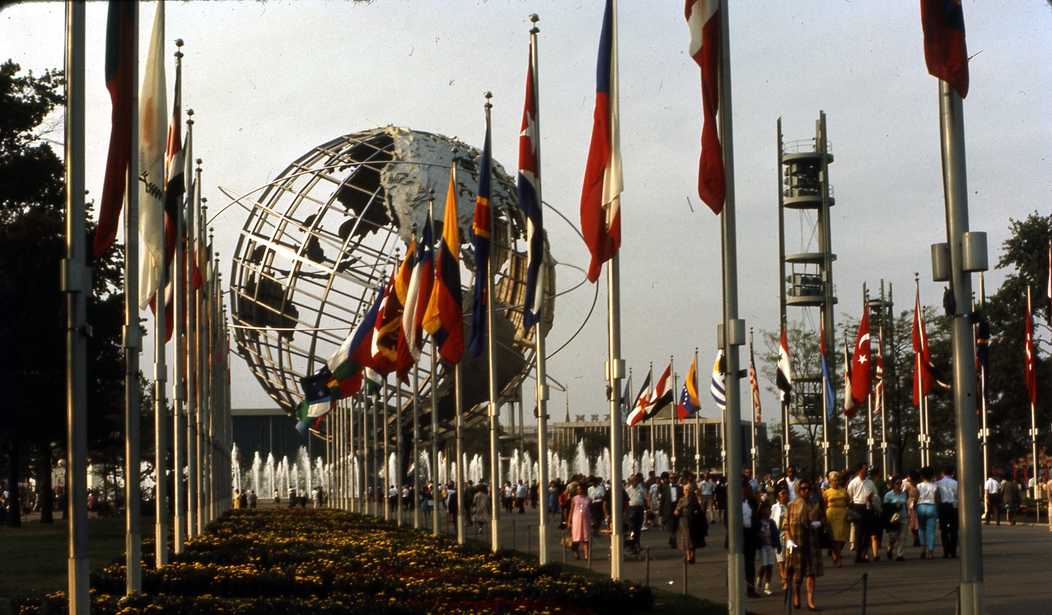Next month marks the 50th anniversary of the 1964-65 World’s Fair, which took place at Flushing Meadows Park in Queens, New York. Today, many people know of it largely because of Walt Disney’s involvement in it. Over the next few weeks, we’re going to take a look at Disney’s contributions to the World’s Fair, but first, let’s glance at the origins of the Fair.
In his excellent essay on the 1964-65 New York World’s Fair, Bill Young sums up its legacy:
The Fair’s theme was “Peace Through Understanding,” dedicated to “Man’s Achievement on a Shrinking Globe in an Expanding Universe” and was often referred to as an “Olympics of Progress.” The theme center was a 12-story high, stainless-steel model of the earth called Unisphere with the orbit tracks of three satellites encircling the giant globe.
By the time the gates closed more than 51 million people had attended the exposition; a respectable attendance for a World’s Fair but some 20% below the projected attendance of 70 million. The exposition ended with huge financial losses and amid allegations of gross mismanagement.
Today the 1964/1965 New York World’s Fair is remembered as a cultural highlight of mid-twentieth century America. It represents an era best known as “The Space Age” when mankind took its first steps toward space exploration and it seemed that technology would provide the answers to all of the world’s problems. The exhibits at the Fair echoed a blind sense of optimism in the future that was prevalent in the late 1950s and early 1960s.
The World’s Fair originated in a conversation among a group of New York businessmen who fondly remembered the 1939-40 World’s Fair, which also took place in Queens. These men sought to provide their children and grandchildren with a similar experience, and they believed a World’s Fair would generate an economic boom for the city as well.
The organizers tapped urban planner Robert Moses to run the Fair. Moses headed the 1939-40 World’s Fair while serving as the city’s parks commissioner. For that earlier event, he turned a garbage dump in Queens into Flushing Meadows Park. The financial failure left the park incomplete – at least in Moses’ eyes, and the builder saw another World’s Fair as the opportunity to complete his achievement.
Moses and the organizers approached the Bureau of International Expositions (BIE) for approval for a World’s Fair in New York City. The organizers believed that an attendance of 70 million would lead to a profit, which called for a two year run. They also wanted to charge rent to the exhibitors. The BIE balked at both stipulations and refused to endorse the Fair. This meant that key nations would refuse to exhibit in Queens and that the Fair would become the only exposition to take place without the blessing of the BIE.
Walt Disney had become aware of the upcoming World’s Fair. In his excellent biography Walt Disney: An American Original, Bob Thomas relates how Walt jumped into the fray:
Walt knew that his organization needed new goals… other challenges that would improve technology and stretch imagination. In 1960, he summoned his staff of planners and told them, “There’s going to be a big fair in New York. All of the big corporations in the country are going to be spending a helluva lot of money building exhibits there. They won’t know what they want to do. They won’t even know why they’re doing it, except that the other corporations are doing it and they have to keep up with the Joneses. Now they’re all going to want something that will stand out from the others, and that’s the kind of service we can offer them…”
Walt saw the Fair as a great opportunity to grow and use other corporations’ money to develop new attractions that could move to Disneyland at the Fair’s end. But beyond Disneyland, Walt had an even greater motivation to get involved with the World’s Fair.
It didn’t take long after Disneyland’s opening for the area surrounding the Anaheim park to close in around it. Tacky tourist culture sullied the Disneyland experience in Walt’s eyes, and he wanted more. He looked for what he would later call “the blessing of size” which would allow him to control not just the park but the area around it. The company began to look to the East Coast.
In another biography, Building A Company: Roy O. Disney And The Creation Of An Entertainment Empire, Thomas explains that Walt’s brother Roy jumped fully on board:
As early as 1959, [Walt] was scouting the possibility of a second park in the East. This time Roy offered no opposition. He had seen Disneyland help propel Walt Disney Productions to a new plateau of prosperity… Roy had become a believer.
In the first half of the 1960s, Walt had already considered locations as diverse as St. Louis, Niagara Falls, North Palm Beach, Florida, and even his boyhood farm in Marceline, Missouri. By 1964, Walt had settled on Central Florida, but the question remained: would East Coast audiences buy into the Disney brand of theme park magic the way Californians did? The World’s Fair in New York City would turn into the perfect test. Buzz Price, whose Economic Research Associates would conduct the location studies for Disney, told Thomas:
[Walt] threw his energy into the New York World’s Fair and used it as a proving ground for the future – the biggest R&D lab forever.
Over the next few weeks, we’re going to take a look at the individual pavilions Walt and the Imagineers developed for the 1964-65 World’s Fair as well as the legacy Disney left at the Fair – and the legacy the Fair left with Disney. Stay tuned.










Join the conversation as a VIP Member